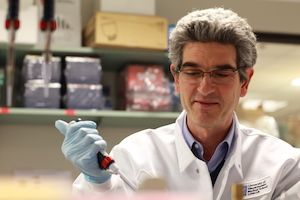 |
|
| Jeremy Luban, MD |
Research from the lab of Jeremy Luban, MD, is shedding light on how hidden reservoirs of HIV-1, the virus that causes AIDS, evade detection by the immune system and elimination by antiviral drugs. These findings, published in Nature Microbiology, show that HIV-1 is maintained in a latent state within CD4+ T cells by cellular proteins known as the HUSH complex, and that the Vpx and Vpr accessory proteins encoded by many viruses related to HIV-1 degrade this complex, thus allowing dormant virus to wake up and start transcription. Targeting the HUSH complex to activate HIV-1 may be an avenue for making latent viral reservoirs susceptible to antiviral therapies.
“If we could find a way to manipulate the HUSH complex itself to wake HIV-1 up from its slumber, the latent virus might then become susceptible to current antiviral drugs,” said Dr. Luban, the David J. Freelander Professor in AIDS Research and professor of molecular medicine. “We have excellent drugs that suppress HIV-1 replication and protect infected people from getting AIDS. But these drugs are not curative. Infection is for life. Once you stop taking the drugs the latent virus rebounds and you’re back where you started.”
HIV-1 inserts its genome into the chromosomes of long-lived immune cells known as memory CD4+ T cells. Once inside the cell’s genome, the virus can then use the cell’s machinery to replicate and ultimately kill the host cell. Patients become immunocompromised, develop AIDS and in most cases, succumb to opportunistic infections.
Once inside a cell’s genome, however, the virus may also lay dormant for long periods of time. While in its inactive state, the immune system and antiviral drugs are unable to recognize and attack infected cells. If antiviral treatment is stopped, the virus will eventually re-awaken and spread. It’s believed that if the virus could be awakened in a controlled way from this dormant state, it could then be treated with antiviral drugs, potentially eliminating these hidden reservoirs and providing a cure.
“The genetic material is always present,” said Luban, “even if it is not active because of the antiviral treatment. Clinically, there’s interest in better understanding this process, since such information might lead to methods that eliminate the virus completely.”
Leonid Yurkovetskiy, PhD, a postdoc in the Luban Lab, discovered that the viral accessory proteins Vpr and Vpx prevented the silencing of HIV-1 transcription that normally happens after infection of T cells. Then, by screening candidate host proteins known to regulate transcription, Dr. Yurkovetskiy discovered that disruption of any of the HUSH complex components mimicked the activity of Vpr or Vpx. He then showed that Vpx bound to the HUSH protein components and degraded them, subsequently activating viral transcription.
“The HUSH complex is an important defensive element against HIV-1 and other retroviral elements,” said Luban. “Vpx or Vpr allow HIV-1 and other retroviruses or retroelements to wake up from suppression by the HUSH complex.”
Luban added, “What’s more, many viruses related to HIV-1 have similar proteins for degrading the HUSH complex. That these viruses have all evolved a way to disrupt this process underscores just how important the HUSH complex is to silence viral replication. If we could target this system, it’s possible that we could turn the virus on just enough for it to be recognized and eradicated by current antiviral therapies.”
A lot also remains unknown about the HUSH complex, he said. “We’re not sure how this complex is recruited to the HIV-1 genome,” he said. “We don’t know why it silences retro-elements in the genome but not other genes. Those are some of the questions that we hope to answer next.”
Related stories on UMassMedNow:
UMMS scientists identify genes that shut down HIV-1; research published in Nature
UMMS researchers receive amfAR grant to eliminate HIV reservoirs using gene editing
UMMS study suggests Ebola virus mutation caused recent outbreak
Luban lands NIDA Avant-Garde award for HIV/AIDS research
Editing HIV out of our genome with CRISPR
UMMS receives $6.1 M to develop model for predicting gene expression in human dendritic cells